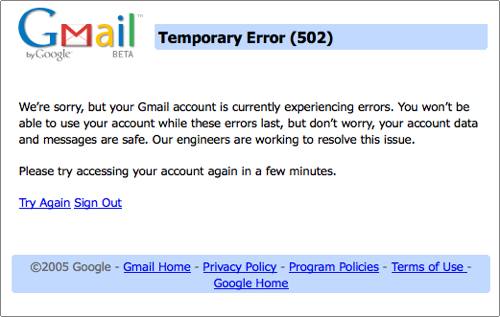Gmail Fails, Google Apologises
![[Credit: Techdare.com]](http://www.techdare.com/wp-content/plugins/wp-o-matic/cache/902ce_gmail-fail.png) Google's Electronic Mail service GMail recently crashed on Wednesday, the 2nd of September for an astonishing 100 minutes! The outage nearly killed the Tweety Twitter again!
But isn't just Google a vast spread network of its never-out-of-run servers. As everyone kept wondering whatever happened with Google and GMail, the service kept responding to the Sign-In requests with the erroneous (but quite friendly!) message:
Google's Electronic Mail service GMail recently crashed on Wednesday, the 2nd of September for an astonishing 100 minutes! The outage nearly killed the Tweety Twitter again!
But isn't just Google a vast spread network of its never-out-of-run servers. As everyone kept wondering whatever happened with Google and GMail, the service kept responding to the Sign-In requests with the erroneous (but quite friendly!) message:
 [Credit: GearDiary.com]
Of course, why do we have to worry????
Better still, 'twas good seeing Google publicly apologizing for the unhappy incident.
Looks like they've got everything tangled, and this one was big!!! Real big!
Google engineering VP Ben Treynor explains on the Gmail Blog:
[Credit: GearDiary.com]
Of course, why do we have to worry????
Better still, 'twas good seeing Google publicly apologizing for the unhappy incident.
Looks like they've got everything tangled, and this one was big!!! Real big!
Google engineering VP Ben Treynor explains on the Gmail Blog:
 Here’s what happened: This morning (Pacific Time) we took a small fraction of Gmail’s servers offline to perform routine upgrades. This isn’t in itself a problem — we do this all the time, and Gmail’s web interface runs in many locations and just sends traffic to other locations when one is offline.
Here’s what happened: This morning (Pacific Time) we took a small fraction of Gmail’s servers offline to perform routine upgrades. This isn’t in itself a problem — we do this all the time, and Gmail’s web interface runs in many locations and just sends traffic to other locations when one is offline.
However, as we now know, we had slightly underestimated the load which some recent changes (ironically, some designed to improve service availability) placed on the request routers — servers which direct web queries to the appropriate Gmail server for response. At about 12:30 pm Pacific a few of the request routers became overloaded and in effect told the rest of the system “stop sending us traffic, we’re too slow!”. This transferred the load onto the remaining request routers, causing a few more of them to also become overloaded, and within minutes nearly all of the request routers were overloaded. As a result, people couldn’t access Gmail via the web interface because their requests couldn’t be routed to a Gmail server. IMAP/POP access and mail processing continued to work normally because these requests don’t use the same routers.The Gmail engineering team was alerted to the failures within seconds (we take monitoring very seriously). After establishing that the core problem was insufficient available capacity, the team brought a LOT of additional request routers online (flexible capacity is one of the advantages of Google’s architecture), distributed the traffic across the request routers, and the Gmail web interface came back online.
|
|
